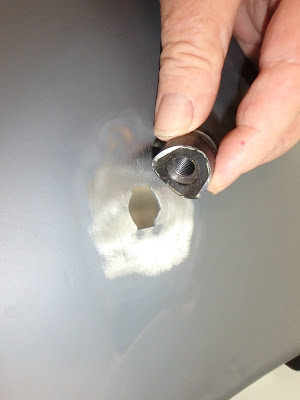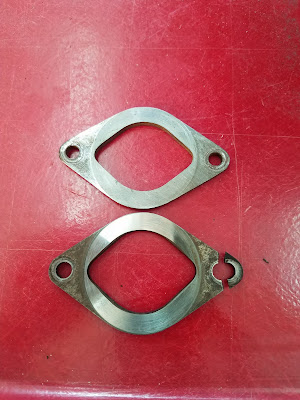Fortunately, I was able to find an original assembly on eBay. Un-fortunately, it appeared to have been left setting upside-down in a pile of wet leaves for years, as rust had eaten through the chrome and pitted the base metal on top.
Chrome would have been an extra-cost option on the top of the cleaner element when the car was new, so I decided to take it back to its standard black-paint finish.
I sandblasted the rust and the flaking chrome away, which also served to roughen the intact chrome so the paint would adhere. I then used several coats of primer and multiple applications of spot-putty to smooth out the pitting.
The bottom half of the cleaner (the oil sump) was not rusted, so it cleaned up easily. While stripping the paint, I did find two cracks in the sheet metal, which I welded back together.
After a few coats of hi-temp black paint the assembly looks pretty much like new.
Back in 1951, virtually all cars used "oil bath" air cleaners, meant to be cleaned and reused for the life of the car. Replaceable paper filters wouldn't become common until the early 60s. It was a very effective way to clean the air before going into the engine, and some off-road vehicles that get used in very dusty environments still use it. But it was a mess when you had to clean it.
Changing the oil in the sump was easy, but cleaning the collected dirt-and-dust-encrusted oil from the wire-mesh element could be downright dangerous! The owner's manual recommends that the element be "lifted out and cleaned in fuel" every 3000 miles. (I remember my father doing that, and then putting a match to it to burn away any residual gas and oil. Fun to watch!)
I don't want to soak my newly-restored parts in gasoline (for many reasons!), so I will be using a paper filter element for daily driving, and just put in the oil-bath element when I take the car to shows.
 |
| 1 1/2 MG TF air cleaners. |
 |
| Image from eBay ad. |
 |
| Before. |
 |
| Pitted chrome and base metal. |
 |
| Note cracks at bottom of both clamping slits. (Wetness is paint stripper.) |
 |
| Shop manual pages showing how an oil-bath filter works. |
 |
| Tops after. |
 |
| Bottoms after. |












































